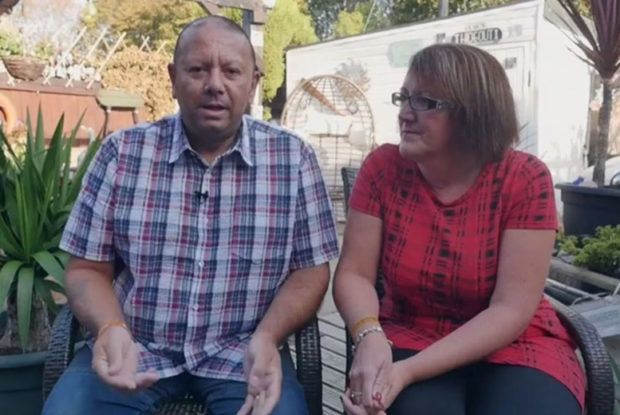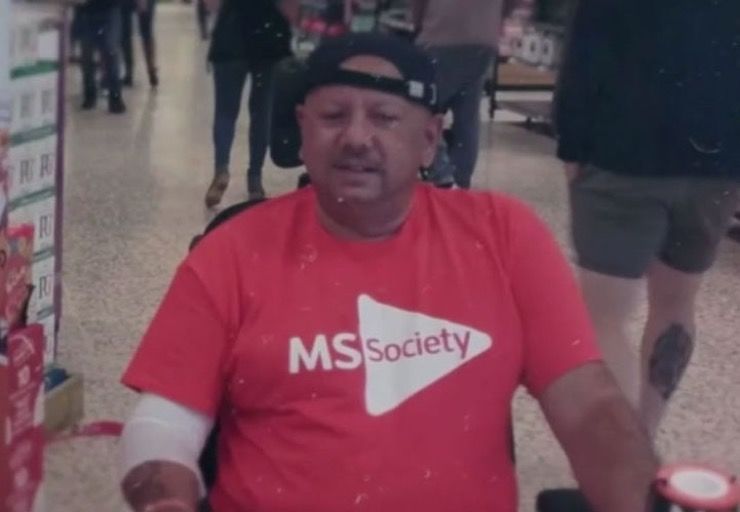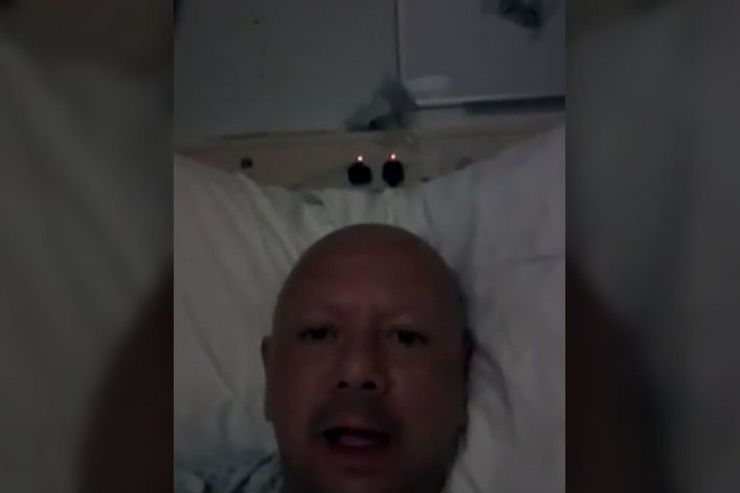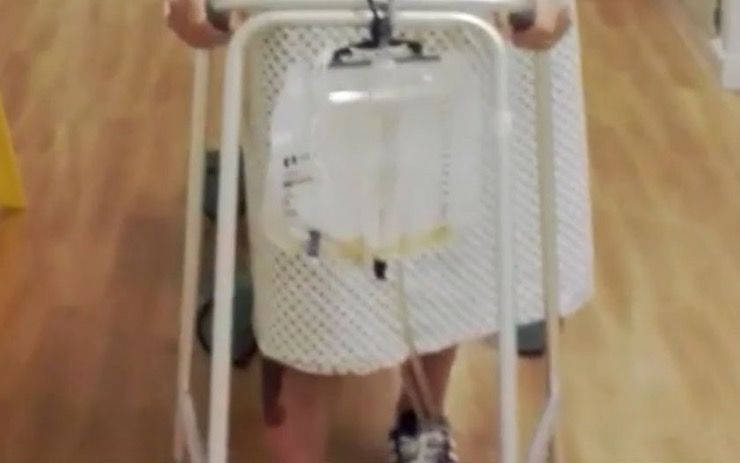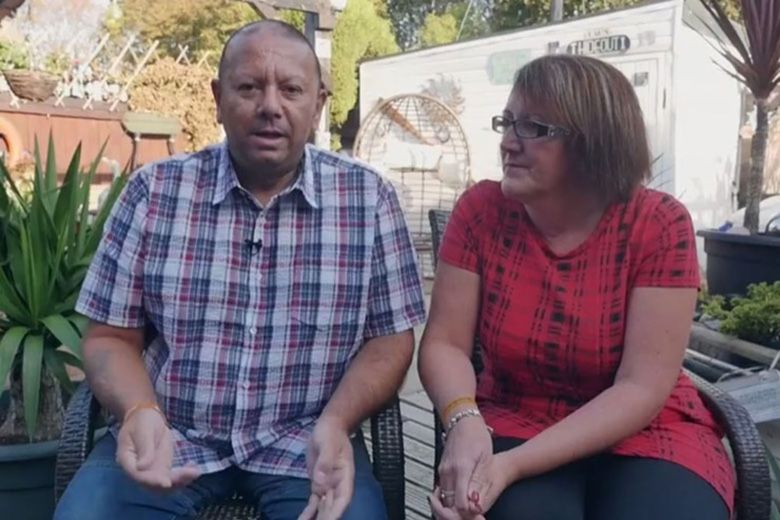Many people who suffer from multiple sclerosis would classify it as an invisible illness. Some have few (if any) visible signs of the disease, while others show obvious symptoms like being unable to walk on their own.
The man in the following story suffered more serious symptoms of MS and he gave up the idea of ever being able to walk again. That was until a documentary changed his entire life…
No Control Of His Legs
For a decade, Roy Palmer had no control of his legs. The 49-year-old from Gloucester, England, had multiple sclerosis (MS), which results in the body’s immune system eating away at the protective covering of the nerves.
Collapsing Out Of Bed
Palmer first noticed something was wrong when he developed a fizzing sensation in his legs, which gradually got worse. One day when he was getting out of bed, the he collapsed as his legs were unable to support him.
Getting A Wheelchair
This eventually caused Palmer to get a wheelchair and his wife, Helen took on the role of caretaker. According to the National Multiple Sclerosis Society, MS is an unpredictable, disabling disease of the central nervous system.
Genetic Predisposition
MS disrupts communication between the brain and the body, and caused Palmer to have no feeling in his legs, forcing him to use a wheelchair. While its cause is still unknown, scientists believe the disease is triggered by an as-yet-unidentified environmental factor in a person who is genetically predisposed to respond.
Life-Changing Documentary
Most people with MS are diagnosed between the ages of 20 and 50, with at least two to three times more women than men being diagnosed. Palmer suffered for 10 years before watching a BBC documentary with his wife in 2016.
BBC’s Panorama
In the documentary called Panorama, the couple saw how two MS sufferers’ lives were transformed after having hematopoietic stem cell transplantation (HSCT). They watched as the patients were wheeled into the hospital, only to be walking when they got out.
Hematopoietic Stem Cell Transplantation
“We sat on the sofa and we both cried, and we thought well if they can do it,” Helen told BBC. After being moved to tears by the program, Palmer asked his general practitioner if he was able to try to the treatment.
Inquiring About HSCT
Palmer learned that HSCT attempts to “reboot” the immune system, which is responsible for damaging the brain and spinal cord in MS. According to the National Multiple Sclerosis Society, in HSCT for MS, blood cell-producing stem cells, which are derived from a person’s own bone marrow or blood, are collected and stored, and the rest of the individual’s immune cells are depleted by chemotherapy.
The Process
The stored stem cells are reintroduced into the body, then migrate with the bone marrow and over time produce new white blood cells. Eventually, they repopulate the body with immune cells. HSCT basically involves taking stem cells from a patient, who then undergoes chemotherapy.
The Goal Of HSCT
The chemo is given with the aim of destroying the immune system, before the stem cells are reintroduced to build a new, healthy immune system. The goal of HSCT is to reset the immune system and stop the inflammation that contributes to active relapsing MS.
Experimental Therapy
The entire process takes anywhere from three to six months and although HSCT has been shown to be effective at treating certain cancers and MS, it is still considered an experimental therapy. It has also been linked to severe kidney, liver, and lung complications.
Risks
While there are a number of known risks and toxicities associated with HSCT, the most serious is the risk of death. The main risk comes from the chemotherapy regimen used to reduce or deplete the immune system. This makes the patient vulnerable to many infections. But despite its risks, Palmer wanted to try to the treatment.
Effectiveness
He discovered that he was the perfect candidate for HSCT since he had highly inflammatory relapsing-remitting MS and has had it for ten years. Still, the effectiveness of the treatment would vary according to Palmer’s individual characteristics and the intensity of his treatment.
Beginning The Treatment
“If [the patients on the documentary] can have that done, on a trial, why can’t I have it done?” Palmer said. So, in 2017, Palmer started the grueling treatment. “Let’s hope it works,” Palmer said in a home video taken just before the treatment.
A Success
Thankfully, for Palmer, the treatment worked. After HSCT, he regained feeling in his left leg within two days. “I haven’t felt that in 10 years,” Palmer told BBC. “It’s a miracle.” He eventually regained feeling in both of his legs and began to walk.
Given A Second Chance
He said that the support from the nurses was “absolutely fantastic” and attributed to his recovery. “I’ve been given a second chance at life,” Palmer said. Since recovering from the surgery, Palmer started volunteering at his local police station.
Trip To Turkey
Thanks to his life changing surgery, Palmer has enjoyed his first stroll on the beach during a holiday trip to Turkey. “Little things like that, people don’t realize what it means to me,” he told BBC. Besides traveling, he’s enjoying the little things in life that most people take for granted, like dancing.
Dancing
Videos of Palmer participating in the “Kiki Challenge,” and “flossing” have gone viral. While most people take part in these trends without thinking too much about it, Palmer is rejoicing in being able to dance, as he wasn’t able to before MS.
Promising Treatment
The MS Society says “HSCT is a hugely promising treatment that has had amazing results for some people.” But since it requires patients to undergo chemotherapy, it can do more harm than good if a patient has a lot of nerve damage.
Favorable Odds
The society added that “its risk is decreasing as more people have the treatment.” Despite being favorable odds, one in 100 patients who use HSCT will still die as a result. But for patients like Palmer, it can prove to be hugely successful.
